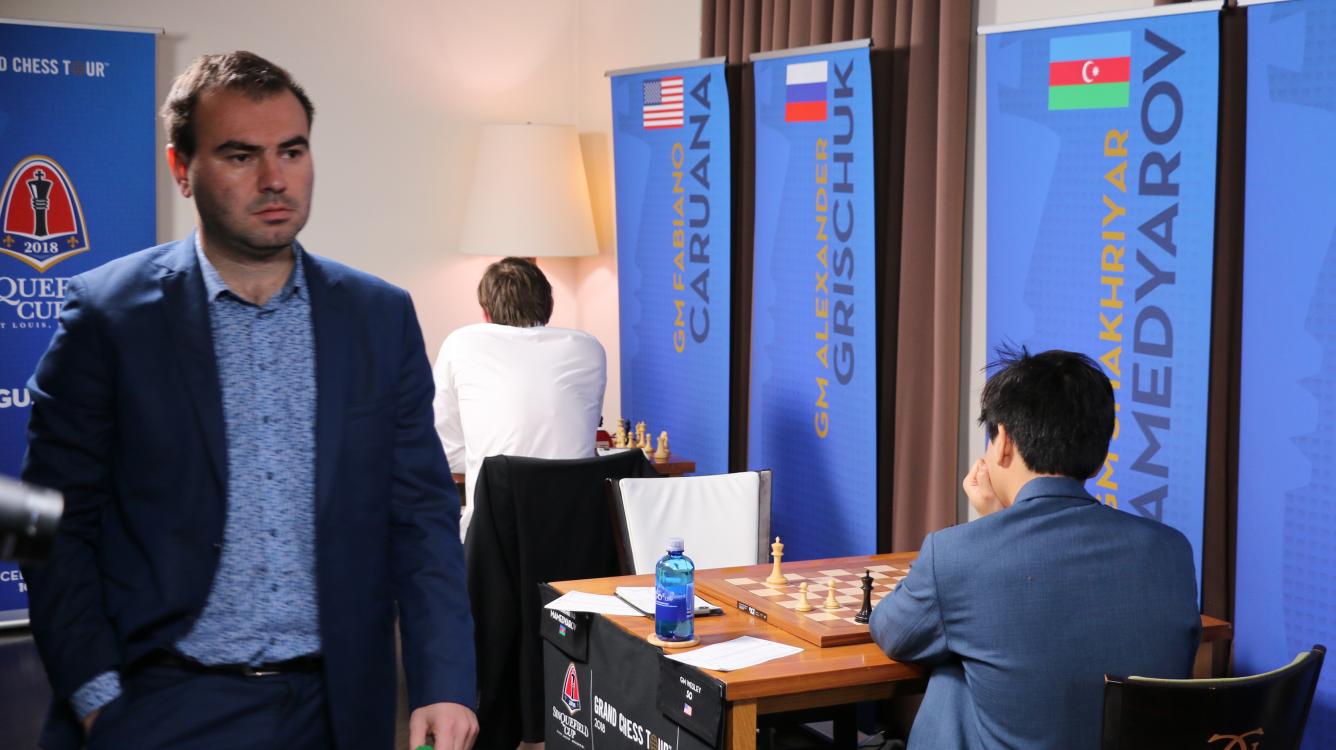
Mamedyarov, Aronian Lead After Sinquefield Cup Opener
Goodbye short films, hello "The Godfather." After today's transition to classical chess, the final game took 36 times as long as blitz thanks to some long, technical endings. Better get a bigger tub of popcorn.
The opening round produced two early leaders at the 2018 Sinquefield Cup: Shakhriyar Mamedyarov and Levon Aronian. There could have been a third, but Fabiano Caruana finally admitted the win was gone after six hours and 15 minutes of trying (in Godfather-speak, that's right about when Fredo is killed).

Levon Aronian is once again standing tall after his strong 2017 didn't lead to much success so far in 2018. | Photo: Mike Klein/Chess.com.
The Caucasian invasion was led off by Mamedyarov, who played one of two early h2-h4-h5 advances. His objectives were much more vicious than the other iteration, and Wesley So started sensing that the aggression of the Azeri had spilled over into another event. Shak had simply switched from throwing his g-pawn down the board to the adjacent file.
The American decided to bail out, but even that was no bargain.
"I didn't realize the endgame is super unpleasant," So said. Previously, he'd been worried about ideas with Ne4 and a sacrifice on his g-pawn. To prevent that, he took twice on c3, which loosened his kingside a little too much.
"I totally underestimated that knight on e5," he said about the ending. "Overall it was a very bad game."

Henrik Carlsen winks. What does he know that we don't?! | Photo: Mike Klein/Chess.com.
So was likely referring to a series of seemingly random knight moves. His steed might have picked up a lot of stamps on its passport, but all it really did was help cluster White's forces in a tight formation in the center of the board.
Mamedyarov told Chess.com that beating So is a good omen. Prior to today, they had drawn every other classical game they'd ever played, except for one.
"I beat him with Black when nobody could beat him and it really helped my game," Mamedyarov told Chess.com about that lone win, at the 2017 Gashimov Memorial. The Azeri said his victory helped catalyze his career -- Mamedyarov went from 2772 to 2800 for the first time about a month later. Shak is now hoping for a similar omen.
He has two other factoids going for him. No repeat winners have come from the five years of the Sinquefield Cup, and every one of the five distinct winners has won the opening round.

Defending champion Maxime Vachier-Lagrave -- roaring like a LyonBeast or bored playing the champ? | Photo: Mike Klein/Chess.com.
After arriving in St. Louis atop the Grand Chess Tour standings, So played to less than his usual standard in the rapid and blitz event. He is suddenly in danger of slipping out of the top four and losing what seemed liked an assured spot in London.
"This happens to every chess player," he said. "I don't have much option; this is my profession and I have to keep fighting."
The other winner, Aronian, got the full point despite overlooking the tenacity of a late endgame resource. You don't often see a one-time 2800 spend 40 minutes in a winning position in a bishop ending, but that's what the Armenian needed after being surprised by 52...g5.
"I realized my gosh, what have I done?" he said. "I kept on thinking to myself, a patzer like me...there are not many people who can misplay this game."
Aronian played 1. e4 exclusively in the Saint Louis Rapid & Blitz, and he trotted it back out again to open the Sinquefield Cup.
"My year so far is pretty dreadful," Aronian said. "It can't get any worse. I might as well try something new to get myself hyped up."

The public may sometimes balk at the Berlin Wall, but it seems other top players are very interested. | Photo: Lennart Ootes/Grand Chess Tour.
The devil-may-care attitude also had a pragmatic reason. Since he sometimes uses the Berlin as Black, playing against it as White may shine a mirror on some improvements he could glean.
"If you want to try to understand certain positions, you have to try to fight with them with the opposite color," he said, adding that he'd be struggling with understanding but today he showed "glimpses of hope."

Why did you acquire Carmelo Anthony? Maurice Ashley proves he can interview about a variety of subjects as here he gives some tough questions to Houston Rockets General Manager (and chess fan) Daryl Morey. | Photo: Lennart Ootes/Grand Chess Tour.
Chess.com asked Aronian exactly what he learned from the White side, as well as other chess and sports topics.
Watch Sinquefield Cup: Levon Aronian on Playing 1.e4 from Chess on www.twitch.tv
Fabiano Caruana said he thought the grandmasters would play even better after the 135 games played at faster time controls. "I think it might raise the level of classical," he said. "Players get some practice beforehand."
Sadly for him, that sharpening didn't trickle down to the ending. He was better for most of it, but missed a few key chances to put the game away. But unlike Aronian-Karjakin, the would-be world champion could not navigate his own opposite-colored bishop ending to victory.

Alexander Grischuk was down to two minutes at this point. In other news, the Earth orbits the sun. | Photo: Lennart Ootes/Grand Chess Tour.
"During the game I felt certain there was a winning position," Caruana said. "I had 50 minutes to his eight minutes but I couldn't cause him any problems. It really comes down to this bad 45. f4 move."
He also lamented an earlier mistake right on the 40th and final move of the opening time control: "Those last moves are always a disappointment."
Maxime Vachier-Lagrave was the other player to push his white pawn to h5 early. But unlike Mamedyarov, the intentions were much more constrained.
"It's kind of thematic; I was happy to see it," Magnus Carlsen told Chess.com about the early h4-h5. Despite the normal aggressiveness of such a spike, the champ suspected that wasn't the intent. "I knew he was going to close the position. In general, this position [after 4...g6] is extremely rare."

The jacket came off early for Carlsen, but he didn't have the operating space needed to prove any advantage. | Photo: Mike Klein/Chess.com.
When asked if he would have preferred his opponent to go for a more mixed position, Carlsen demurred without hesitation: "I'm not going to complain about a draw as Black."
Analysis by GM Alejandro Ramirez, courtesy of Grand Chess Tour:
Unlike his oft-repeated quote from the 2016 World Championship that he generally doesn't believe in fortresses, today Carlsen had to accept that the wall held. That's better than his countryman and helper thought was going to happen:
Really poor opening for Magnus. Making a draw would be a success with those squares on d5 and f5. pic.twitter.com/774YRiqhfd
— Jon Ludvig Hammer (@gmjlh) August 18, 2018

Carlsen had a rare answer in store for MVL's off-beat 3.Nc3. | Photo: Mike Klein/Chess.com.
Lastly, Hikaru Nakamura didn't get much as white against Viswanathan Anand and they drew in the first game to finish. Still, that's better than his opening-round loss to Anand in the beginning of the rapid event that just concluded (not that it mattered much since Nakamura went on to win the overall title anyway).
The five-time world champion (nine times if you count all the rapid and blitz titles!) said that once he traded off his IQP, he was just fine.


Graphics courtesy Spectrum Studios.
The Sinquefield Cup, the final qualification leg of the Grand Chess Tour, is a nine-round tournament from August 17-28. At the end of the tournament, four players will qualify for the London finals. The games in St. Louis begin at 1 p.m. Central U.S. time daily (8 p.m. Central Europe).
Earlier reports:


